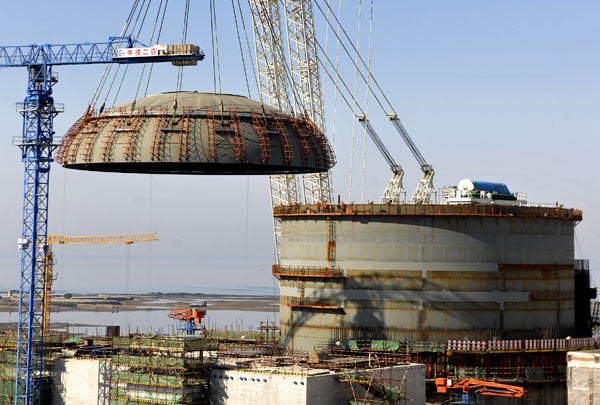Clean-energy projects get go-ahead
By Zhao Yinan (China Daily) Updated: 2015-12-17 07:52
 |
|
A steel dome is hoisted onto the No 1 reactor at Haiyang nuclear power plant in Shandong province in March. China plans to have an installed nuclear power capacity of 58 gigawatts by 2020. [Photo/Xinhua] |
An executive meeting of the State Council presided over by Premier Li Keqiang approved the projects on Wednesday to offer new incentives amid slowing economic growth.
The approvals will also help the country fulfill its commitment on climate change.
According to experts, China is poised to achieve economic growth of about 6.9 percent this year, barely meeting the government's annual target of around 7 percent. The growth rate is the slowest for 25 years.
The meeting approved the Wudongde hydropower station on the Jinsha River on the border of Sichuan and Yunnan provinces, part of the upper reaches of the Yangtze River.
The two nuclear projects are both in coastal areas, one in Fangchenggang in the Guangxi Zhuang autonomous region, using third-generation technology, and the other in Lianyungang, Jiangsu province.
A statement released after the meeting said construction of the three projects is an important measure to sustain economic expansion and restructure the country's energy sector.
"Projects in line with current security standards and national strategies should be approved soon," it added.
Strict management is required for the nuclear projects to ensure high security standards during construction, as well as proper handling of the ecological impact, water pollution and the resettlement of residents in the affected areas.
China has 22 nuclear reactors in operation and 26 under construction, according to the National Energy Administration. It plans to have more than 110 operational nuclear reactors by 2030.
- China's 2016 GDP growth likely to be 6.6-6.8%: Think tank
- Russian stewardess shines on Hainan Airlines
- Report: Layoffs may loom next year
- World joins Chinese carriers' cabin crews
- Clean-energy projects get go-ahead
- China central bank projects 2016 growth at 6.8%
- Internet companies eye tie-ups with Russian peers
- Inspur's overseas push based on domestic R&D
















